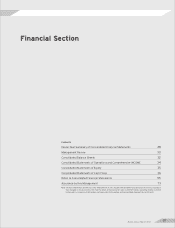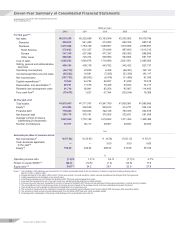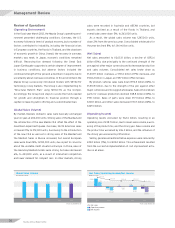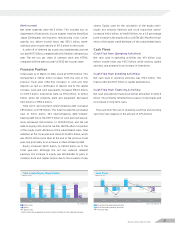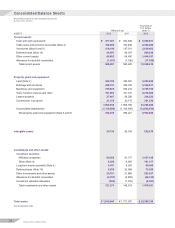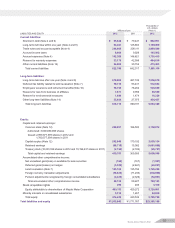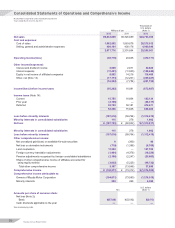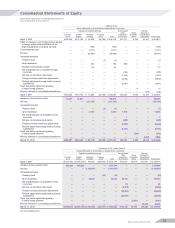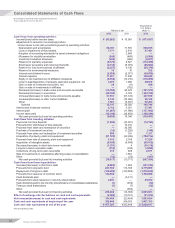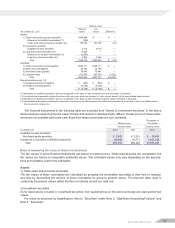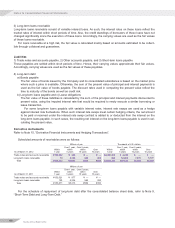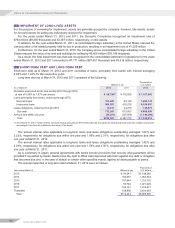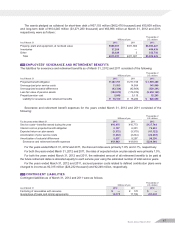Mazda 2012 Annual Report Download - page 39
Download and view the complete annual report
Please find page 39 of the 2012 Mazda annual report below. You can navigate through the pages in the report by either clicking on the pages listed below, or by using the keyword search tool below to find specific information within the annual report.
Notes to Consolidated Financial Statements
Mazda Motor Corporation and Consolidated Subsidiaries
1 BASIS OF PRESENTING CONSOLIDATED FINANCIAL STATEMENTS
The accompanying consolidated financial statements of Mazda Motor Corporation (the “Company”) and its consoli-
dated subsidiaries have been prepared in accordance with the provisions set forth in the Financial Instruments and
Exchange Law of Japan and its related accounting regulations, and in conformity with accounting principles gener-
ally accepted in Japan (“Japanese GAAP”), which are different in certain respects as to application and disclosure
requirements from International Financial Reporting Standards (“IFRS”).
For the convenience of readers outside Japan, the accompanying consolidated financial statements have been
reformatted and translated into English (with some expanded descriptions) from the consolidated financial state-
ments of the Company prepared in accordance with Japanese GAAP and filed with the appropriate Local Finance
Bureau of the Ministry of Finance as required by the Financial Instruments and Exchange Law of Japan. Certain
supplementary information included in the statutory Japanese language consolidated financial statements is not
presented in the accompanying consolidated financial statements.
The translation of the Japanese yen amounts into U.S. dollars is included solely for the convenience of readers
outside Japan, using the prevailing exchange rate at March 31, 2012, which was ¥82 to U.S. $1.00. The translations
should not be construed as representations that the Japanese yen amounts have been, could have been, or could in
the future be converted into U.S. dollars at this or any other rate of exchange.
2 SIGNIFICANT ACCOUNTING POLICIES
Principles of consolidation
The accompanying consolidated financial statements include the Company and significant companies, over which
the Company has power of control through majority voting rights or existence of certain conditions evidencing control
by the Company. Investments in affiliates, over which the Company has the ability to exercise significant influence
over operating and financial policies of the investees, are accounted for by the equity method.
The consolidated financial statements include the Company and 56 subsidiaries (51 in the year ended March 31,
2011). In addition, 13 affiliates (14 in the year ended March 31, 2011) are accounted for by the equity method.
The consolidated year-end balance sheet date is March 31. Among the consolidated subsidiaries, three companies
(two at March 31, 2011) have a year-end balance sheet date of December 31, which is different from the consoli-
dated balance sheet date. Adjustments necessary in consolidation are made for material transactions that have
occurred between the balance sheet date of these subsidiaries and the consolidated year-end balance sheet date.
Results of consolidated statements for the year ended March 31, 2011 include 15 months’ operations of four
consolidated subsidiaries that have changed their balance sheets date from December 31 to March 31.
The difference between acquisition cost and net assets acquired is shown as consolidation goodwill and
amortized on a straight-line basis over a period (primarily 5 years) during which each investment is expected to
generate benefits.
Foreign currency translation
Receivables and payables denominated in foreign currencies are translated into Japanese yen at the exchange rate
at the fiscal year-end; gains and losses in foreign currency translation are included in the income of the current
period.
Balance sheets of consolidated foreign subsidiaries are translated into Japanese yen at the rates on the subsid-
iaries’ balance sheet dates except for equity accounts, which are translated at historical rates. Income statements of
consolidated foreign subsidiaries are translated at average rates during the subsidiaries’ accounting periods, with the
translation differences prorated and included in the equity as foreign currency translation adjustments and minority
interests in consolidated subsidiaries.
Mazda Annual Report 2012 37


